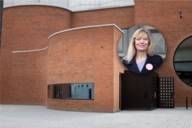
Astrid Neubert has lived just two Isar bridges away from the Schlachthofviertel district for more than twenty years. So, she experiences almost daily how quickly and constantly everything changes here – not only when she guides interested locals or guests through the hip district.
“What I like here is that the residents want to preserve diversity. You notice that, for example, in Zenettiplatz (square) with its flowerbeds tended by the residents; a place where people meet to chat, exchange ideas and watch. It is striking how many small and individual shops there still are here, just like in Zenettistrasse. Regular visits to the Open Wall along Tumblingerstrasse are always worthwhile, because it changes and is redesigned so quickly.
Like many Munich residents, I like to enjoy a sundowner in the evening on the deck of Alte Utting (disused pleasure boat). From here, you can see over the roofs of Grossmarkthalle (wholesale market hall) to far beyond the Sendling neighbourhood – everything grown and unadorned – and that is precisely what makes it so incredibly beautiful! It's a view that definitely doesn't live up to the cliché of Munich and shows how diverse our city is after all.“
Slaughtering still takes place in the Schlachthofviertel, although not on the same scale as a hundred years ago. Creative interim uses spring up on the vacated spaces – such as Bahnwärter Thiel, an alternative cultural project made of discarded underground subway wagons and shipping containers, and Alte Utting, a former pleasure boat that was parked on a railway bridge and now invites visitors to enjoy the gastronomy and culture.
The district is home to the Grossmarkthalle (wholesale market hall) and the Schlachthof (slaughter house), which is why it is also referred to as the “stomach of Munich“. The culinary offer is equally varied and fresh – from traditional Weißwurst (white sausages) at seven in the morning to oyster platters in the evening – everything is available.
Schlachthofviertel is undergoing change and this is also reflected in the cultural landscape: between colourful containers and the city's longest legal graffiti wall, new buildings and new openings are popping up and blend in well with the tried-and-tested – like Gasteig’s (cultural centre) alternative quarter HP8 or the new Volkstheater (theatre).
The area around the Grossmarkthalle (wholesale market hall) also offers opportunities for private grocery shopping – for example, at Frischeparadies or Magnus Bauch’s butcher’s shop. Apart from products from all over the world, you’ll find plenty of Munich craftsmanship here.
The Schlachthofviertel is known for its diverse gastronomic offerings and creative openness – so it's no wonder that Munich's craft beer brewers settle here. “Tilmans Biere“ opened the “Frisches Bier“ bar years ago, and in 2020, the “Bierkiste“ was added. The Munich brewery of the same name is responsible for “True Brew“, while the “Hop Dog“ serves delicious hot dogs with various craft beers from all over the world.